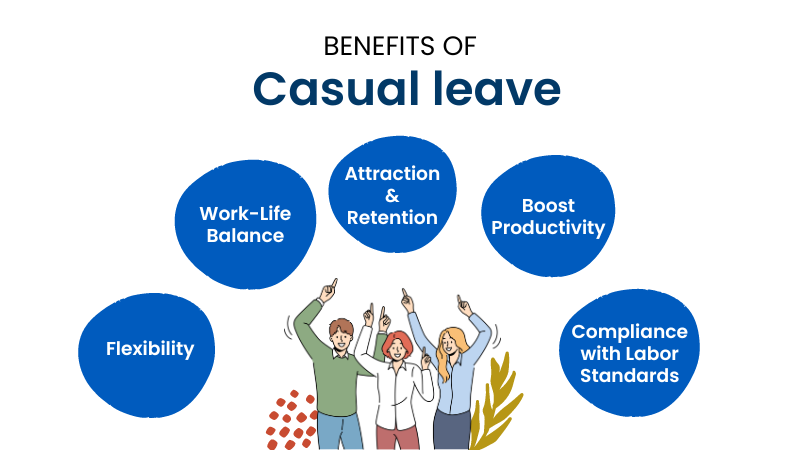What is Casual leave?
Casual leave is a time-off given to employees for various reasons such as for personal reasons, family events, unforeseen circumstances or during non-emergency situations. Casual leave is also known as personal or unplanned leave. These are usually for a shorter duration and are readily approved by the employer. The casual leave (CL) cannot be carried forward and is availed by the employee in a given calendar year.
It is a privilege given to employees by employers as a part of their leave policy provision. The duration of casual leaves (CL) varies as per various organizations’ policies, processes, and regulations.
Casual leave (CL) Rules
To avail the casual leaves in your organization, certain rules are required to be adhered which include:
1. Accrual and Allocation:
The casual leave is accrued by an employee at the beginning of every calendar year of the organization or on the employee’s joining date (employment anniversary). The process of CL allocation may vary for different companies depending on the company’s policies, employment tenure of an employee, and other factors.
2. Usage
The casual leaves are usually availed for a shorter duration for a maximum of three days or less for personal reasons, family requirements, or other non-urgent or unplanned circumstances.
3. Notice of Leave
Some companies might require employees to give leave notice in advance whereas in case of sudden illness, short notice for CL is acceptable.
4. Approval Procedure
It is formally acquired by the employee from the employer by giving a leave application.
5. Carry-over Provision
It varies as per organizations’ policies. Some companies have “use it or lose it” provision while few others allows a certain amount for “carry over”.
6. Documentation
In cases of emergencies where the maximum CL leave exceeds, an employee is required to provide supporting documents.
7. Restrictions
There may be leave rules that hinder employees from taking CL for consecutive days.
8. Consequences of Violation
Violating casual leave rules can result in disciplinary actions against the employee as well as loss of pay due to disobedience.
Also Read: What are Different Types of Leave in India?
Factors to Consider while Applying For a Casual Leave
The key factors to consider for applying for a casual leave include the following, Here are some:
Leave Balance
Before applying for casual leave do not forget to check with your CL balance. As the exceeding limit can cause you salary deductions.
Nature of Leave
Evaluate the urgency of availing the CL. If not required save it for necessity or personal requirements due to unforeseen circumstances.
Documentation (If required)
Provide supportive documents if required in cases of medical emergencies. Providing a prior notice for leave is preferable if CL is not availed in unplanned circumstances.
Leave Provision
Check with your company’s leave provision to see if there is any sandwich leave provision or the maximum of CL that can be availed to avoid salary deductions and other disciplinary actions.
Work Calendar
Check with your work calendar before availing of casual leave to avoid a potential adverse impact on work commitments.
Accumulation & Expiry
The accumulation and expiry of casual leave are essential to be checked to avoid loss of pay.
Communication
Communicate the leave duration and reason clearly to the employer in order to keep away from miscommunication.
FAQs
1. What is earned leave?
Earned leave, often referred to as annual leave or vacation time, is a type of leave granted to employees based on their tenure and the duration of their service with a company. This leave is earned over time and allows employees to take paid time off from work for rest, relaxation, or personal activities, contributing to a healthy work-life balance.
2. Difference between Casual and Earned leaves?
Casual leave is typically unplanned and taken for short durations due to unforeseen circumstances, while earned leave, earned over time, is planned for longer durations in advance, such as vacations. Casual leave is often subject to immediate approval, while earned leave requires advanced planning and approval based on work urgencies.
Earned leave accrues over time, it can be carried forward, while casual leave cannot be carried forward to the next year. The purposes and usage patterns of the two types of leave differ, with casual leave addressing immediate needs and earned leave providing extended breaks for planned relaxation.
| Aspect | Casual Leave | Earned Leave |
|---|---|---|
| Nature of Leave | Unplanned, short-term for unforeseen circumstances. | Planned, earned over time, used for longer durations like vacations. |
| Entitlement | Set annually, often without carryover. | Accrued over time, potential for carryover. |
| Purpose | Immediate personal needs or emergencies. | Planned vacations, rest, and relaxation. |
| Approval Process | Immediate approval, shorter notice periods. | Planned in advance, subject to workforce considerations. |
| Usage Pattern | Sporadic, short-term usage. | Longer durations for extended breaks. |
| Accrual and Carryover | Usually does not accrue, limited carryover. | Accrues, potential for carryover to the following year. |
| Usage Restrictions | Fewer usage restrictions. | May have timing restrictions for balanced workforce planning. |
3. Is casual leave paid?
Casual leave may be paid or unpaid depending on the company’s policies. Employees should refer to their employment contracts or the company’s leave policy for availing the casual leave and getting an insight into the total duration of casual leave in their company’s leave rules provision.
4. How many casual leaves in a year?
The number of casual leave days you get in a year depends on your company’s rules and your employment agreement. Check your employment contract or ask your HR department to find out how many casual leave days you have. The generic casual leave duration might vary from a day to three or more. Yet, the number of casual leaves in a year is not universal and is subject to alterations as per your company policies.
5. What are the benefits of having Casual leave in the workplace?
1. Flexibility: Immediate time off for personal needs without affecting the overall leave balance.
2. Work-Life Balance: Promotes a healthier work-life balance, hence enhancing job satisfaction.
3. Attraction and Retention: Contributes to an attractive work environment, enhancing employee connection with the organization and resulting in robust employee retention.
4. Boost Productivity: Enables prompt resolution of personal matters, minimizing work disruptions and enhancing work productivity.
5. Compliance with Labor Standards: Aligns with legal requirements, ensuring compliance with labor standards.


